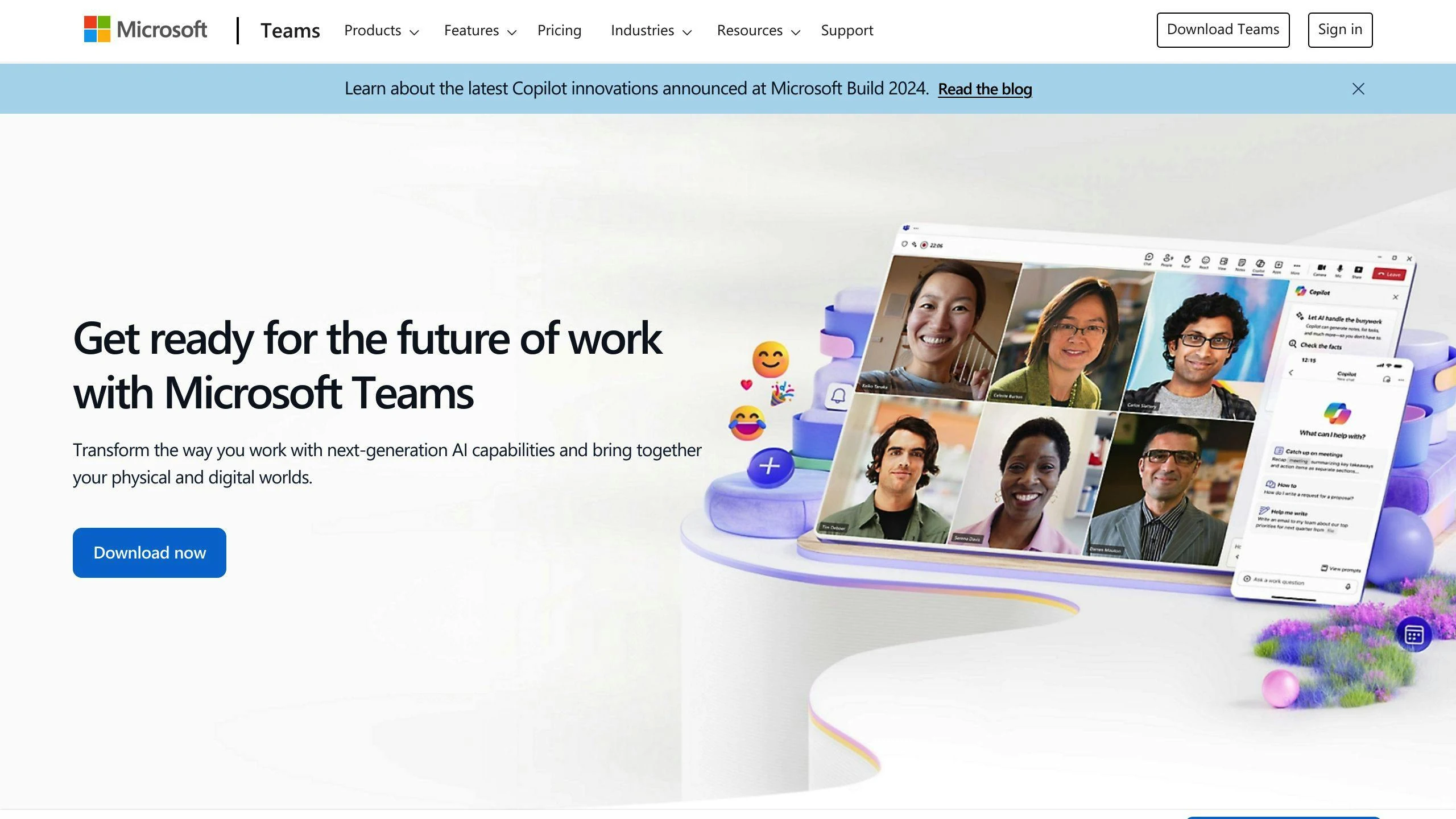Here’s a quick guide to naming your Microsoft Teams effectively:
- Keep names short (30 characters max)
- Use prefixes to categorize teams (e.g., PRJ-, DEPT-, Public-)
- Avoid special characters and dates
- Include department and project info
- Add location codes for global teams
- Use security labels for sensitive data
Key benefits of good naming standards:
- Faster information retrieval
- Reduced duplicate teams
- Clearer team purposes
- Improved organization and searchability
Quick tips for implementation:
- Set up auto-naming rules in Microsoft Entra ID
- Train users on naming conventions
- Regularly audit team names for compliance
- Use tools like nBold for automation in large orgs
| Aspect | Best Practice | Example |
|---|---|---|
| Length | Under 30 characters | “PRJ-84719-Website Redesign” |
| Prefix | Use for categorization | “DEPT-Marketing-Brand Guidelines” |
| Global Teams | Include location code | “EMEA-Sales-Q4 Plan” |
| Security | Add security level | “Secret-Finance-Q3 Forecast” |
Remember: Consistent naming makes Teams more efficient and user-friendly.
Basic Naming Rules
Clear, consistent naming rules in Microsoft Teams are key for smooth organization. Here’s what you need to know:
Main Rules for Team Names
Keep names short – 30 characters max. This helps with visibility and search.
Use prefixes to add context:
| Prefix | Example | Use |
|---|---|---|
| PRJ- | PRJ-84719-Eclipse Renovation | Project teams |
| DEPT- | DEPT-Human Resources | Department teams |
| Public- | Public-Chess Club | Open teams |
Keep prefixes to 12 characters or less.
Don’t use special characters like ~, “, #, %, &, *, :, <, >, ?, /, , {, or |. They can mess up SharePoint URLs.
Skip dates unless you really need them. They make teams feel old fast.
Use spaces instead of hyphens. It’s easier to read and better for SharePoint URLs.
Meeting Legal and Company Rules
Set up a naming policy in the Azure AD Management Portal. This keeps names consistent across your org.
Create a blocked words list. Upload it as a CSV file in your naming policy settings.
Use sensitivity labels instead of words like “Confidential” in team names.
Add company-specific info using Azure AD attributes. For example:
TEAM-[Department]-[Group Name]
For global companies, add region or country codes to tell apart global and local teams.
“Good team naming is all about keeping it simple and clear.” – Microsoft Teams Best Practices
Stick to these rules, and you’ll have a more organized Teams setup. It’ll be easier to find what you need and avoid duplicate teams.
If you want to make naming even easier, check out nBold. They offer tools to automate and enforce naming rules, which can be super helpful for big companies with lots of teams.
Parts of a Team Name
Creating good team names in Microsoft Teams means combining key elements for clarity and context. Let’s break it down:
Using Prefixes and Suffixes
Prefixes and suffixes help organize and categorize teams. They’re quick identifiers that make finding the right team easier.
Here’s how to use them:
- Keep prefixes short (12 characters max)
- Use spaces instead of hyphens or underscores
- Be consistent across similar team types
Common prefix examples:
| Team Type | Prefix | Full Name |
|---|---|---|
| Project | PRJ | PRJ Eclipse Renovation |
| Department | DEPT | DEPT Human Resources |
| External | EXT | EXT Client Project Alpha |
“Adding consistent prefixes to team names can add organization, structure and consistency to your teams.”
Department and Team Labels
Including department and team info helps users quickly identify a team’s purpose and ownership. This is key in large organizations with multiple departments and cross-functional teams.
Guidelines:
- Use clear department acronyms or names
- Include sub-team identifiers when needed
- Be consistent across similar departments
Naming convention example:
[Department]-[Team Name]-[Optional Descriptor]
Real examples:
- HR-Total Benefits
- IT-Infrastructure-Cloud Migration
- MKTG-Digital-Q4 Campaign
Project and System Tags
For project-based teams or those tied to specific systems, tags improve searchability and context.
Best practices:
- Use project IDs or codes when applicable
- Include system abbreviations for IT-related teams
- Add timeframes for temporary projects
Project and system tagging examples:
| Project/System Type | Naming Convention | Example |
|---|---|---|
| IT Projects | [PRJ]-[ID]-[Name] | PRJ-84719-CRM Upgrade |
| Temporary Teams | [TEMP]-[Duration]-[Name] | TEMP-6M-Budget Review |
| System-specific | [SYS]-[Abbreviation]-[Purpose] | SYS-SAP-User Training |
Combining these elements – prefixes, department labels, and project tags – creates informative and easy-to-navigate team names. The goal? Balance clarity with brevity.
“Choose a name related to your department or sector, such as ‘Service,’ ensuring it reflects the team’s purpose and aligns with your overall organisational structure.” – Microsoft Teams Documentation
Using these naming conventions improves user experience and enhances team management in Microsoft Teams.
Setting Up Auto-Naming Rules
Let’s dive into how you can set up automatic naming rules for Microsoft Teams. This will make your organization’s collaboration smoother and more organized.
Microsoft Entra ID Rules
Want to create consistent names for Microsoft 365 groups, including Teams? Here’s how to set up a group naming policy in Microsoft Entra ID:
1. Log into the Microsoft Entra admin center as a Group Administrator
2. Go to Groups > All groups > Naming policy
3. Click on Group naming policy to view or edit policies
When creating your policy, keep these tips in mind:
- Don’t go overboard with prefixes and suffixes. Keep them under 53 characters combined.
- Use attributes like [Department] or [Country] to automatically fill in team names based on who’s creating them.
- Create a “no-no” list of words to keep team names appropriate.
Here’s a solid naming convention example:
[Department]-[GroupName]-[Country]
This could give you team names like “HR-Benefits-USA” or “IT-CloudMigration-UK”.
Sticking to the Rules
Setting up rules is one thing. Making sure people follow them is another. Here’s how to keep everyone on track:
| Method | What It Is | Why It’s Good |
|---|---|---|
| Teach Users | Give clear guidelines on naming | People are more likely to follow rules they understand |
| Automate It | Use Microsoft Entra ID’s built-in policy enforcement | Rules are applied consistently |
| Check Regularly | Review team names to make sure they follow the rules | Catch and fix any names that don’t fit |
Heads up: Global Admins can bypass these naming policies. Make sure everyone, from the top down, knows why these rules matter.
nBold: Your Naming Superhero

Need extra help managing team names, especially if you’re a big company? Check out nBold. It’s a tool that can automate and enforce naming rules.
nBold can:
- Create custom templates for different types of teams
- Set up channels automatically with preset naming structures
- Blend naming rules with your IT policies
With nBold, you can make sure your naming rules are followed every time someone creates a new team. This takes a load off your IT department’s shoulders.
“When teams are named consistently, people use Microsoft Teams better and more successfully.” – David Francoeur, Principal Author
sbb-itb-8be0fd2
Special Naming Rules
As companies grow, their Microsoft Teams naming conventions need to keep up. Let’s look at some naming strategies for bigger, more complex organizations.
Names for Global Teams
For companies with offices worldwide, adding location info to team names is key. It helps tell local and global teams apart, making it easier for people to work together across countries.
Here’s a simple way to name global teams:
[Location]-[Department]-[What It's About]
Some examples:
- EMEA-Sales-Q4 Plan
- APAC-Marketing-New Product
- NA-IT-Cloud Move
To make this work:
- Use standard location codes (like NA for North America)
- Keep department names the same across regions
- Make the description clear and short
“Using the same naming rules worldwide has made creating teams 30% faster and helped our offices work together better.” – Sarah Chen, Global IT Director at TechGlobal Inc.
For companies with more complex setups, you could use this:
| Part | What It Means | Example |
|---|---|---|
| Location | Region or country code | EMEA, US, CN |
| Department | Which part of the company | Sales, HR, R&D |
| Team Type | What the team does | Project, Committee |
| Description | Short, clear explanation | Q4 Plan, New Product |
Example: EMEA-Sales-Project-Market Growth
Security Level Labels
Adding security levels to team names helps control access and protect data. This is really important for companies that deal with sensitive info or have to follow strict rules.
Here’s how to add security levels to your team names:
[Security Level]-[Department]-[Team Name]
Security levels could be:
- Public
- Internal
- Secret
- Top Secret
Some examples:
- Public-Marketing-Brand Rules
- Internal-HR-Employee Survey
- Secret-Finance-Q3 Predictions
- Top Secret-Legal-Merger Plans
To use security levels in names:
- Choose clear security levels that match your company’s data rules
- Teach people how to use these labels when they make teams
- Check team names often to make sure they’re following the rules
“Adding security levels to our team names has cut down on data leaks by 40% in the last year.” – Michael Roberts, CISO at SecureEnterprises LLC
For a more detailed approach, you could use this:
| Part | What It Means | Example |
|---|---|---|
| Security Level | How secret is it | Public, Secret |
| Department | Which part of the company | Finance, R&D |
| Purpose | What the team does | Project, Committee |
| Description | Short, clear explanation | Budget Check, New Product |
Example: Secret-Finance-Project-Q4 Audit
Fixing Naming Problems
Even with solid naming rules, problems can pop up. Here’s how to tackle common issues with team names in Microsoft Teams.
Fixing Name Conflicts
When team names clash or break the rules, you need to act fast. Here’s what to do:
1. Spot the Problem
Keep an eye on your team names. Look for any that don’t match up or follow the rules.
2. Talk to Team Owners
Let team owners know about the naming policy and why changes are needed.
3. Rename the Team
Follow these steps:
- Log out of Microsoft Teams
- Change the name in Azure Active Directory
- Wait 24-48 hours for the change to stick
- Log back into Teams
“It usually takes up to 24 hours, sometimes 48. You might need to log out and back in for it to work.” – Chris, Microsoft Community Member
4. Fix Sync Issues
If names aren’t updating, try this:
| Step | What to Do | What Should Happen |
|---|---|---|
| 1 | Log out and back into Teams | Forces a sync with the server |
| 2 | Update user info in Teams Admin Center | Manually starts a sync |
| 3 | Check Azure AD for changes | Makes sure changes are at the source |
5. Handle Channel Renaming
Be careful when renaming channels:
- Renaming in Teams might not sync with SharePoint
- Renaming in SharePoint can make content vanish
“We know about this issue. The Teams and SharePoint teams are working on a fix to keep things consistent when you rename a channel in Teams.” – Shawn, Microsoft Community Expert
Checking Name Compliance
Make sure team names follow your company’s rules:
1. Use Naming Policies
Set up a group naming policy in Microsoft 365:
- Add prefixes and suffixes (up to 53 characters total)
- Use things like [Department] or [Country] for automatic naming
- Make a list of words you don’t want used
2. Check Names Regularly
Set up a schedule to review team names:
| How Often | What to Do |
|---|---|
| Weekly | Look for new names that break the rules |
| Monthly | Check if names are consistent overall |
| Every 3 Months | Update the naming policy if needed |
3. Automate the Process
Use Microsoft 365 admin tools to enforce naming rules automatically.
4. Teach Your Users
Help people understand the naming rules:
- Make a simple guide for creating team names
- Offer training on how to name teams
- Show examples of good and bad team names
5. Handle Special Cases
Sometimes, you might need to allow names that don’t fit the usual rules:
- Ask why the special name is needed
- Set up a way to approve these names
- Keep a list of all approved special names
Summary
Let’s recap the key points for setting up effective Microsoft Teams naming standards in your organization.
Main Points
Consistency is crucial
A consistent naming policy helps users find the right teams quickly and boosts adoption.
Keep names short
Aim for team names under 30 characters to avoid truncation and improve readability.
| View | Character Limit |
|---|---|
| Pinned | 45 |
| Normal | 34 |
Use prefixes and suffixes
Categorize teams with prefixes or suffixes:
| Type | Convention | Example |
|---|---|---|
| Project | PRJ-[ID]-[Name] | PRJ-84719-Eclipse Renovation |
| Department | DEPT-[Name] | DEPT-Human Resources |
| Public | Public-[Name] | Public-Chess Club |
Automate with Microsoft Entra ID
Use Microsoft Entra ID to set up and enforce naming policies automatically across Teams, Outlook, and SharePoint.
Block problematic words
Create a list of blocked words to maintain professionalism and avoid confusion.
Include relevant info
Add details like department, company, location, country, or project ID to team names.
Train your staff
Educate users on naming conventions to reduce duplicate teams and improve organization.
“Without consistent Microsoft Teams naming standards, this process becomes taxing and inaccurate as end users have no reliable ‘memory’ from which to draw to assist in accurately identifying whether certain information is the information they are seeking.” – ShareGate Expert
Audit regularly
Review team names periodically to ensure compliance with your naming policy.
Think globally
For multinational organizations, use location codes:
[Location]-[Department]-[Team Name]
Example: “EMEA-Sales-Q4 Plan” or “APAC-Marketing-New Product”
Add security labels
For sensitive information, consider security level indicators:
[Security Level]-[Department]-[Team Name]
Example: “Internal-HR-Employee Survey” or “Secret-Finance-Q3 Predictions”
FAQs
How to change naming convention in Microsoft Teams?

Want to update your Microsoft Teams naming convention? Here’s how:
- Head to Settings
- Click Naming policy
- Go to the Group naming policy tab
- Under Current policy, pick if you want a prefix, suffix, or both
- Check the boxes to apply your changes
“A naming policy can help you and your users identify the function of the group, membership, geographic region, or who created the group.” – Microsoft Entra ID Documentation
What’s the naming convention for Microsoft groups?
Microsoft group names follow this structure:
Prefix[GroupName]Suffix
Keep in mind:
- You can set multiple prefixes and suffixes
- Only one [GroupName] allowed in the setting
- Prefixes and suffixes together can’t exceed 53 characters
What’s a group naming policy?
A group naming policy in Microsoft Teams helps you:
- Spot group function, members, or creator
- Sort groups in the address book
- Stop certain words from being used in group names and aliases
Why use a naming policy? Here’s why:
| Benefit | What it does |
|---|---|
| Consistency | Keeps names uniform across your org |
| Searchability | Makes finding the right groups easier |
| Compliance | Ensures names follow company rules |
| Organization | Helps sort and manage groups better |
What’s the max name length in Microsoft Teams?
Microsoft Teams names should be between 30 and 36 characters, depending on letter case.
| View Type | Character Limit |
|---|---|
| Pinned | 45 |
| Normal | 34 |
Fun fact: Some users have made team names up to 800 characters long! But don’t do that. Stick to 30-36 characters for the best results.

